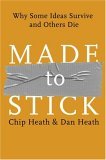Why Some Ideas Survive and Others Die
In Made to Stick, Chip and Dan Heath have addressed head-on one of the biggest problems with implementing change in people’s thinking and behavior — crafting the concept in a way that makes it compelling.. “sticky” in their words.
The book is an extension of the concept described in Gladwell’s The Tipping Point which outlines “stickiness” as one of the things required for an idea to catch on and spread.
Read this book, then take a look at your presentations and training materials, and compare the messages with the examples in the book. Make an honest assessment:
Is your message:
Simple? Is the core concept immediately apparent?
Unexpected? Does it come across in a way that compels retention?
Concrete? Do analogies and examples make the concept something people can see, touch, feel in their minds (or even better, physically)?
Credible? Does it just make sense?
Emotional? Does it appeal to people’s feelings, or is it “just the facts” with cold analytical presentation.
Have stories? Does the presentation include experiences people can visualize?
Other books on organizational transformation, like John Kotter’s Leading Change talk about the critical importance of creating a sense of urgency, creating a vision, communicating that vision, but Made to Stick goes further and gives you tools to actually make sure your message gets across in a way that compels people to act differently.

Hey Mark,
I enjoyed both books Made to Stick and the Tipping Point and recently read a book by Jay Heinrichs called Thank you for Arguing that takes a deeper dive into the rhetoric used to make a message sticky. There was an article written about Jay Heinrichs that I think you will enjoy, http://www.businessweek.com/articles/2012-03-14/jay-heinrichss-powers-of-persuasion.